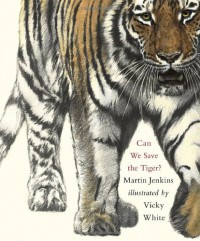Bookworm Blurbs
I absolutely adore reading - my love for books has had a huge impact on my life! I'm going to grad school to be a children's/YA librarian.
Can We Save the Tiger?

Tigers are pretty special — and so are ground iguanas and partula snails and even white-rumped vultures. But these and many other animals are in danger of disappearing altogether, joining the dodo, the marsupial wolf, the great auk, and countless other animals we will never see again. Using the experiences of a few endangered species as examples, Martin Jenkins highlights the ways human behavior can either threaten or conserve the amazing animals that share our planet. Vicky White’s stunning portraits of rare creatures offer a glimpse of nature’s grace and beauty — and give us a powerful reason to preserve it. (source)
This is a picture book that I read for my Resources for Children class. I don't think that I had heard of it prior to this class, but the cover looks familiar, so I had probably come across it at some point. My professor selected it for our unit on informative texts - and this book is most definitely informative!
I have to confess that I am not the most environmentally oriented person. I don't like being outside (except for reading at the beach and only if it's 85+ degrees), I'm not a fan of animals except for dogs and cats, and environmental issues simply have never really touched my heart. I certainly acknowledge that it's important for us to take care of the Earth and do our best not to harm it any more than we already have... but there are other issues that are nearer and dearer to my heart. So, this was not a book that I expected would impress me. Boy, was I wrong.
This picture book intends to inform readers about endangered species - a topic that has been covered in countless books, both for children and adults. This particular book targets older elementary children - it's far too advanced to be read by an early reader and it's a bit dry for a read-aloud. But the illustrations are GORGEOUS and the message is conveyed to readers in a lyrical, beautiful way. Basic facts about each species are included too, in a statistical format that reminded me of baseball cards. I think that this will appeal to kids who don't like "traditional" forms of reading. In my class, we talked about how there are many, many, many different forms of reading. Often, we assume that if a child doesn't like to read traditional books, then he or she doesn't like to read. But that child might devotedly read baseball cards or the current events section of the newspaper - both of which are indeed forms of reading that should be valued and acknowledged by professionals. I believe that the essentially bullet-point layout of many of the facts in this book will appeal to some of these less traditional readers - and, again, the illustrations are absolutely irresistible.
It should be noted that this book most definitely has an agenda. It's a positive agenda, to be sure - to raise awareness about endangered species - but this is still an agenda. This is not just a non-fiction book about tigers that can be used for a biological report about that species. In fact, this book only talks about tigers for a few pages, and then moves on to other animals. In this way, the title might be misleading to some readers. I don't consider this to be a negative quality by any means, but it's still something to keep in mind: this author's goal is not simply to inform, but to persuade.
I was very much impressed by this book. I believe that this is a book that should be included in children's libraries of all sorts - public, elementary, and those of upper elementary classrooms. This is a non-fiction book that will entrance and captivate readers, which is pretty difficult to do with non-fiction, in my opinion. I thoroughly enjoyed reading it, and if you're environmentally conscious or if you appreciate beautiful picture books, I recommend that you pick this one up.
 7
7 






